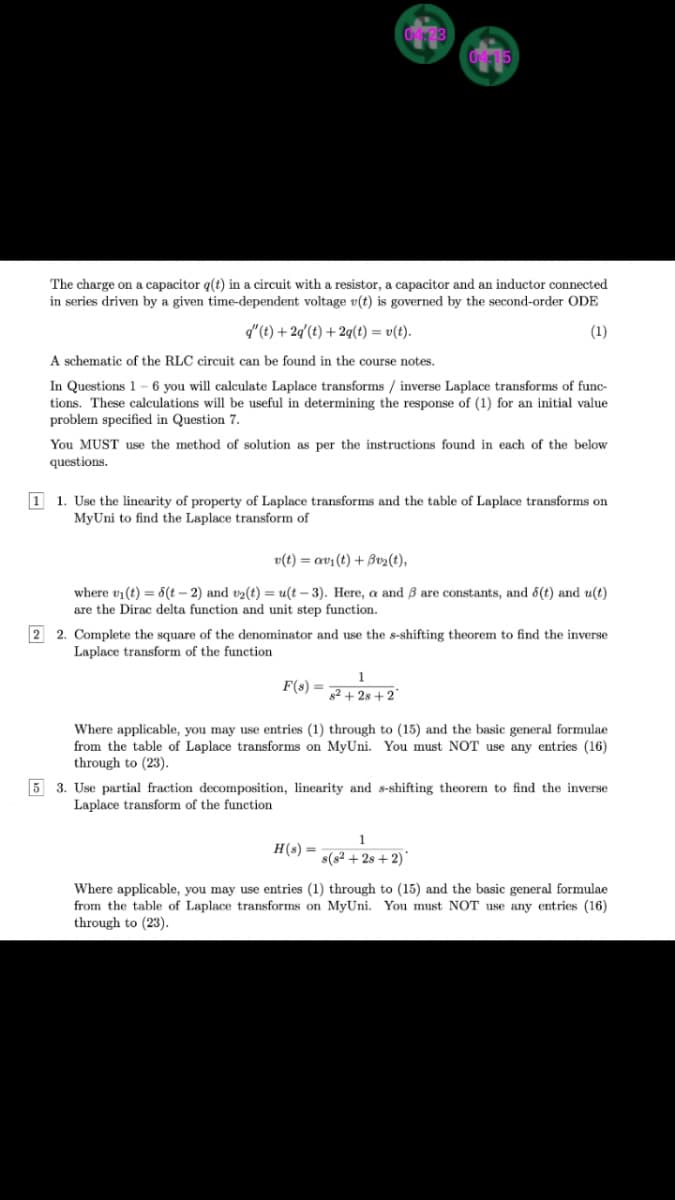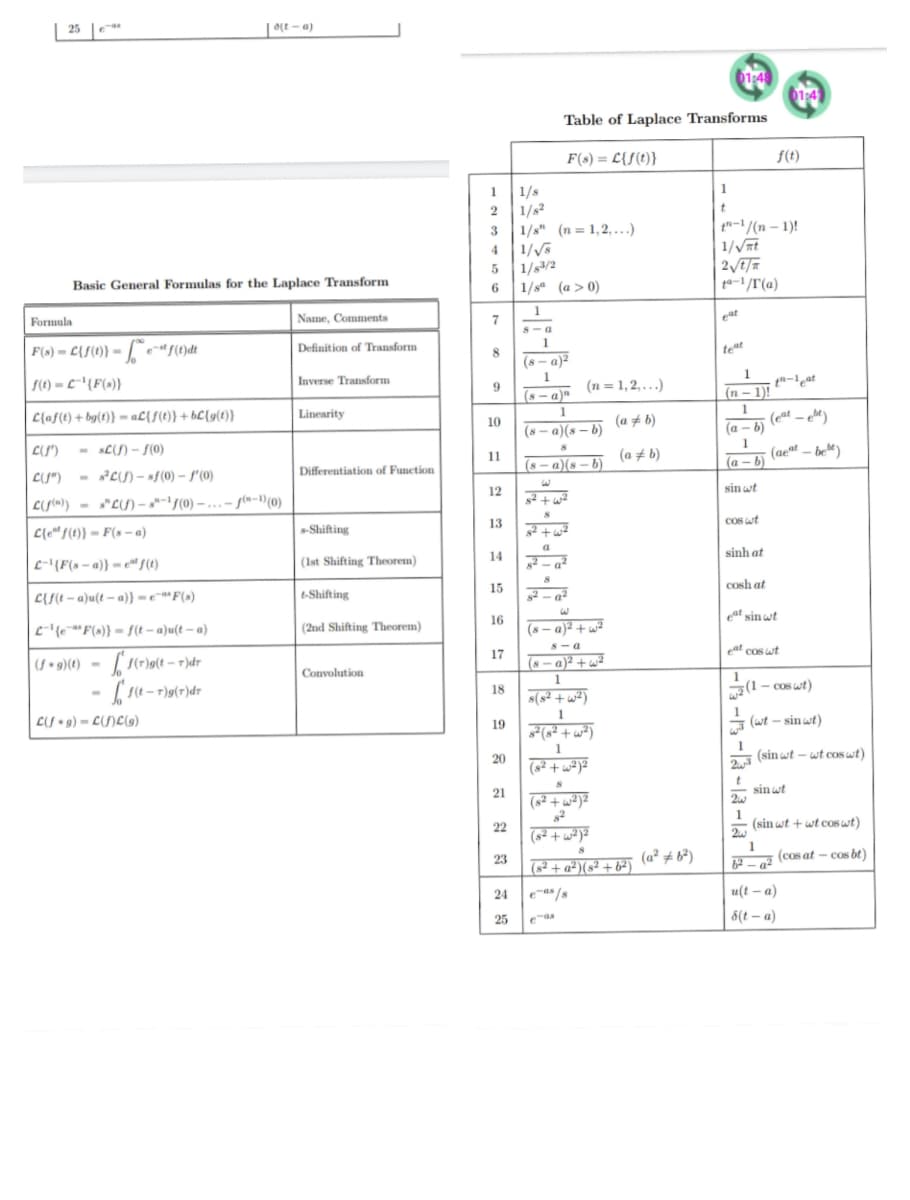5 3. Use partial fraction decomposition, linearity and s-shifting theorem to find the inverse Laplace transform of the function H(s) s(s² + 2s + 2)'
5 3. Use partial fraction decomposition, linearity and s-shifting theorem to find the inverse Laplace transform of the function H(s) s(s² + 2s + 2)'
Advanced Engineering Mathematics
10th Edition
ISBN:9780470458365
Author:Erwin Kreyszig
Publisher:Erwin Kreyszig
Chapter2: Second-order Linear Odes
Section: Chapter Questions
Problem 1RQ
Related questions
Question
100%
Uh need to solve only (question 3)
I also attached the table that is given in questions to solve uh only need to solve the q3 in one hour and get thumb up plz plz plz solve perfectly and handwritien soloution needed plz
I need perfect soloution according to question requirements plz

Transcribed Image Text:The charge on a capacitor q(t) in a circuit with a resistor, a capacitor and an inductor connected
in series driven by a given time-dependent voltage v(t) is governed by the second-order ODE
d"(t) + 2q'(t) + 2q(t) = v(t).
(1)
A schematic of the RLC circuit can be found in the course notes.
In Questions 1 - 6 you will calculate Laplace transforms / inverse Laplace transforms of func-
tions. These calculations will be useful in determining the response of (1) for an initial value
problem specified in Question 7.
You MUST use the method of solution as per the instructions found in each of the below
questions.
1 1. Use the linearity of property of Laplace transforms and the table of Laplace transforms on
MyUni to find the Laplace transform of
v(t) = av1 (t) + Bv2(t),
where vi(t) = 6(t – 2) and v2(t) = u(t – 3). Here, a and ß are constants, and 6(t) and u(t)
are the Dirac delta function and unit step function.
2 2. Complete the square of the denominator and use the s-shifting theorem to find the inverse
Laplace transform of the function
F(s) =
82 + 28 + 2°
Where applicable, you may use entries (1) through to (15) and the basic general formulae
from the table of Laplace transforms on MyUni. You must NOT use any entries (16)
through to (23).
5 3. Use partial fraction decomposition, linearity and s-shifting theorem to find the inverse
Laplace transform of the function
Н() —
s(s² + 2s + 2)*
Where applicable, you may use entries (1) through to (15) and the basic general formulae
from the table of Laplace transforms on MyUni. You must NOT use any entries (16)
through to (23).

Transcribed Image Text:| 25 |**
| OLt - a)
1:4
1:4
Table of Laplace Transforms
F(s) = L{S(t)}
f(t)
1/s
1/s²
1/s" (n = 1,2, ...)
| 1/V
1/s3/2
1/s (a > 0)
1
1
t"-1/(n – 1)!
1//mt
3
4
Basic General Formulas for the Laplace Transform
6.
t0-1/T(a)
1
Formula
Name, Comments
eat
8- a
1
F(s) = L{S(1} = [e"()dt
Definition of Transform
teat
(8 – a)²
1
| (1) = c-'{F(»)}
Inverse Transform
9.
(8 – a)™
1
(n = 1, 2, .)
(n-1)!
1
(eat – e")
C{af(t) + bg(t)} = aL{f(t)} + bL{g(t)}
Linearity
1
(a # b)
10
(8 – a)(s – b)
(a – b)
1
(aet – be")
- sCf) – f(0)
(a ± b)
11
(8 – a
(s – b)
(a – b)
Differentiation of Function
- PL(S) – sf(0) – s'(0)
12
sin wt
s² + w?
cism) = "L(J) – *-'s(0) – .. – fln-1)(0)
13
Cos wt
C{e“{(t)} = F(s – a)
-Shifting
a
14
sinh at
L-{F(s – a)} = e" S()
(Ist Shifting Theorem)
15
cosh at
L{{(t – a)u(t – a)} = e~**F(s)
t-Shifting
at sin wt
16
(8 – a)² + w²
{e"F(s)} = f(t – a)u(t – a)
(2nd Shifting Theorem)
8-a
17
eat cos wt
(S • 9)(t) =
[(r)a(t – r)dr
(6 – a)² + w²
Convolution
1.
(1 – cos wt)
18
s(s² + w²)
CJ • 9) - C)C()
19
(wt – sin wt)
1
(sin wt – wt cos wt)
2
1
20
(8² + w?)Z
sin wt
21
(s² + w?)Z
1
(sin wt + wt coswt)
22
(s² + wa )Z
(a² # b³)
1
(cos at - cos bt)
23
(s² + a²)(s² + b²)
62 - a
24
u(t – a)
25
eas
6(t – a)
Expert Solution
This question has been solved!
Explore an expertly crafted, step-by-step solution for a thorough understanding of key concepts.
Step by step
Solved in 6 steps with 5 images

Recommended textbooks for you

Advanced Engineering Mathematics
Advanced Math
ISBN:
9780470458365
Author:
Erwin Kreyszig
Publisher:
Wiley, John & Sons, Incorporated

Numerical Methods for Engineers
Advanced Math
ISBN:
9780073397924
Author:
Steven C. Chapra Dr., Raymond P. Canale
Publisher:
McGraw-Hill Education

Introductory Mathematics for Engineering Applicat…
Advanced Math
ISBN:
9781118141809
Author:
Nathan Klingbeil
Publisher:
WILEY

Advanced Engineering Mathematics
Advanced Math
ISBN:
9780470458365
Author:
Erwin Kreyszig
Publisher:
Wiley, John & Sons, Incorporated

Numerical Methods for Engineers
Advanced Math
ISBN:
9780073397924
Author:
Steven C. Chapra Dr., Raymond P. Canale
Publisher:
McGraw-Hill Education

Introductory Mathematics for Engineering Applicat…
Advanced Math
ISBN:
9781118141809
Author:
Nathan Klingbeil
Publisher:
WILEY

Mathematics For Machine Technology
Advanced Math
ISBN:
9781337798310
Author:
Peterson, John.
Publisher:
Cengage Learning,

